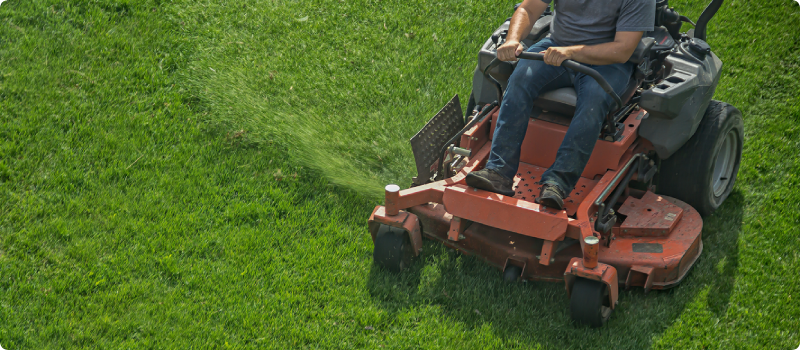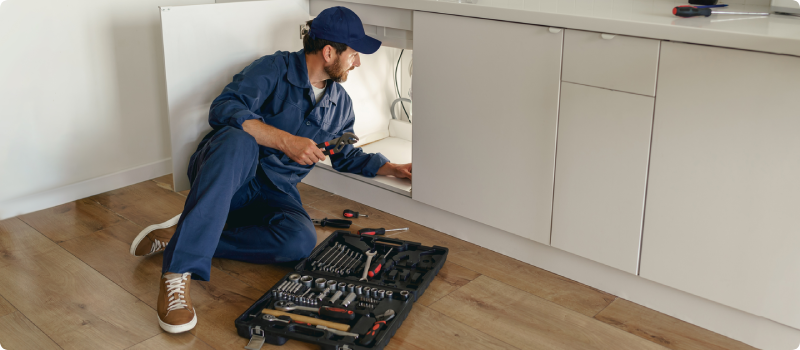How much should you budget for home maintenance?
Updated June 22, 2021 . AmFam Team
Updated June 22, 2021 . AmFam Team
If you take a look around your neighborhood, you’ll probably see many different homes — and odds are some of those homes will look better than others. Every homeowner has their own style when it comes to maintaining their humble abode but one thing’s certain: taking care of your home as it ages is going to cost you. If you’re diligent about staying ahead of issues, you may pay a little more out of pocket every month, but in the long run, you may wind up saving thousands.
Depending on how a home has been cared for, you can expect to pay about 1% of your home’s current market value in annual maintenance expenses. The good news is there are ways to think about saving and budgeting for the inevitable repair or replacement of your home’s big-ticket items.
Do you know how much to budget for home maintenance? We’re here to help you narrow down that elusive number so you can manage your home’s budget with greater certainty.
Of course, you want your home to look great. Balancing that ideal with your finances can be another story. That’s why a solid budget is so important when it comes to managing house maintenance costs. If you’ve put aside cash to spend on upcoming projects — and saved up with each paycheck — you’ll likely find getting the work done is possible. You’ll be able to boost the value of your house and its curb appeal, too!

By placing a certain percentage of your home’s value into savings every year, you’ll have a reserve for big-ticket items when the time comes to make a major purchase. Because appliances will eventually need to be swapped out, and sooner or later the roof will need replacing, having that savings in place can make a big difference. You’ll be better prepared for unexpected problems as well. Here are a few items that will likely need your attention around your home:
It’s fair to say that forecasting the future is next to impossible. But you can weigh a number of important factors together and emerge with an idea of what your yearly house maintenance budget will need to be. Here are a few key factors that affect your home’s maintenance budget:
Where your home is located. The physical position of your home — relative to hills, water flow channels, flood plains and more — has an impact on how well a home will fare over the years. For instance, you can expect higher yearly home maintenance costs for homes that see large amounts of water in the basement every year.
Your home’s condition. Homeowners that take pride in their home and do what they can to keep it running smoothly benefit in many ways. They may spend a bit more up front, but their yearly home maintenance costs are more predictable as a result. When older homes have been well-maintained, they typically have furnaces that last longer, too.
The age of your home. As your home ages, it’s going to need upkeep and repairs. The age of a home is a big predictor in its overall health. Average repair and maintenance costs can be minimized in older homes by hiring professionals to regularly check in on your appliances and systems. Homes built 30 to 40 years ago will usually require more spending to maintain than homes built within the last decade.

Local weather can take its toll on your home. Take a look at the various ways you’ll spend on your home depending on the seasons and region where you live.
Winter climates can accelerate home maintenance expenses. Physical stressors on your home like temperature changes, ice and snow can impact your home’s structure. When insulation around your foundation is lacking, pipes are more likely to burst in frigid temperatures. If your gutters aren’t cleaned out after the leaves have fallen, they’re more likely to create ice dams.
Humid regions can affect your home’s property maintenance costs. Coastal areas and humid regions can harbor conditions where mold and mildew can flourish. Frequent rainfall or exposure to tropical storms can beat up your roof as temperatures shift from very hot and sunny to wet and cool all year long.
Mild weather can help your home to last longer. If the weather’s just fine most of the year, your HVAC systems won’t need to be running — and they’re likely to stay in better repair as a result. The rest of your home’s systems are more likely to stay in better shape, too.
Most home maintenance expenses can be anticipated when you’re regularly spending on maintenance. You’re more likely to be caught off guard by big ticket maintenance expenses when major home systems are neglected. Here’s a look at average home maintenance costs vs. the average cost to replace these items.
Average annual maintenance cost | Average replacement cost | |
|---|---|---|
HVAC | $110 - $200 | $3,000 - $6,000 |
Fireplace | $125 - $375 | $400 - $2,000 |
Water heater | $80 - $100 | $750 - $1,400 |
Gutters | $75 - $150 | $1,000 - $2,500 |
Your total home maintenance budget is made up of many separate expenses — some of them quite small — like gas for the lawn mower or filters for your furnace. But you’ll need to budget for other home expenses, too. Take a look at how individual average maintenance costs can add up quickly:
Monthly maintenance cost | 5-year maintenance cost | |
|---|---|---|
Repairs and general maintenance | $170 | $10,200 |
HOA fees | $250 | $10,200 |
Utility bills | $200 | $12,000 |
Property taxes | $220 | $13,200 |
Lawn care and snow removal | $130 | $7,800 |
Homeowners insurance | $80 | $4,800 |
Private mortgage insurance | $160 | $9,600 |
So, how much should you budget for home maintenance costs? There are a few good rules of thumb to consider that can help you sock away cash for a day in the future when you’ll need it.
There are many ways to consider saving up and budgeting for home maintenance costs. The 1% rule is a good standard because it’s so easy to remember. Put aside 1% of the total purchase price of your home for home maintenance repairs. For example, a $250,000 home would require you to save $2,500 annually, or about $209 per month.
It’s a rough estimate that doesn’t consider labor costs or materials, and other factors can contribute to this base price.
Budgeting for the eventual breakdown and replacement of major home systems like a new roof or replacing a sump pump may not be easy, but it is possible. If you’re wondering about how to estimate property maintenance costs, the square foot rule can be helpful, and it’s another really easy way to put money away for repairs and home maintenance.
Budget about $1 for every square foot of livable space, every year, for annual home maintenance costs. And this rule is also applicable for estimating new home maintenance costs. So, a 2,500-square-foot home would require a $2,500 budget annually or about $209 per month.
Another great way to budget for home maintenance is to put away 10% of your main monthly expenses every month. That’s 10% of your mortgage, 10% of your property taxes and 10% of your insurance costs placed into a savings account every month.
Suppose you’re spending this much every month:
10% of each of those figures is: 150 + 35 + 20, or a monthly savings plan equating to $205. Estimating your annual home maintenance costs can be difficult but saving up that cash doesn’t have to be.

Even if you save for home maintenance costs, unexpected losses, such as a house fire, can instantly exhaust those resources. That's why having an up-to-date home insurance policy is essential to your home maintenance budget.
Contact your American Family Insurance agent for a policy review today. They can help ensure your home insurance delivers the peace of mind protection you need. They may also be able to help you save money on your premium with our bundling discounts and savings programs.
This article is for informational purposes only and based on information that is widely available. This information does not, and is not intended to, constitute legal or financial advice. You should contact a professional for advice specific to your situation.